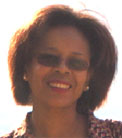Curriculum vitae
 Myriam Lubino-Bissainte is a Doctor of Earth Sciences of the University of Pierre and Marie Curie of Paris VI (UPMC VI).
Myriam Lubino-Bissainte is a Doctor of Earth Sciences of the University of Pierre and Marie Curie of Paris VI (UPMC VI).
She is the General Director of MIRAI Sustainable Development Consultancy. This Agency replace the ancient BISMANPRINTVEC which worked on disaster management and mitigation between 1997 and 2001, in Guadeloupe and the Caribbean area.
"MIRAI Sustainable Development Consultancy" is specialized in audit, consulting, expertise and management of all natural, technological and professional linked risks, in order to help people (politicians, economic and industrial managers, employees, children, schools, aged people, and all the other population of a region or a country) in living with risks and practicing a sustainable development for their country. In this agency there are four departments call C.R.E.E.(Consultancy, Research, Education, Edition).
This Agency has been accredited by the UNO for the World Conference on Disaster Reduction Process. In January 2005, Dr. Myriam Lubino-Bissainte had been invited at the Symposium on "Building Safer Communities against Disasters," organized by the United Nations Centre for Regional Development (UNCRD Disaster Management Planning Hyogo Office) in cooperation with other agencies, as part of the UN World Conference on Disaster Reduction (WCDR). The International Symposium aims to discuss community based disaster management issues that UNCRD Hyogo Office has focused on over the years. She had been also a participant to the symposium entitled, "Safer Communities: Linking the World to Kobe - Kobe to the World", and the session entitled, "Community Based Disaster Management".
On November 1st she will participate at the International Lisbon Conference commemorating the 250th Anniversary of the 1755 Lisbon Earthquake and Tsunami.
She is now working on a comparative study with Japan, titled "Comparison between Japan and Guadeloupe about how and what is done for earthquake effects reduction".
She is also achieving a special mission of consultancy and achieving the "DICRIM" (Informative Document on Natural and Technological Risks) for the greatest industrial and economical city of Guadeloupe, named Baie-Mahault.
In 2005, she wrote a paper on Case Studies and Best Practices on Education for Sustainable Development towards effective Disaster Reduction and enhancing human security compiled and published by UNESCO and Kyoto University, Titled : "An example of an earthquake crisis management in a day-care center or child care center of Guadeloupe (F.W.I)".
In October 2004 she participated with UNO in Geneva (Switzerland) in the Preparatory Committee of the organization of WCDR World Conference on Disaster Reduction.
Between 2001-2004 she achieved:
- two Disaster Management Documents to educate and inform the High Junior School Directors and children (Natural and Technological Risk Management Operational Manuals),
- an exhibition on the Seismic Risk and the historical earthquake which hit the Caribbean zone and especially Guadeloupe the 8th February of 1843,
- a synthetic paper on the sensitizing of the 34 Mayors of Guadeloupe to the seismic risk within the framework of a mission of consulting for the Interministerial Service of Defense and Civil Protection (SIDPC) of Prefecture of Guadeloupe
- a Document of information for the Caribbean zone called: "Communication during volcanic crisis: an operations manual for the Caribbean" - DFID Project R7406 - Protecting Vulnerable Small Islands by Improving Forecasting and Warning - London 2001-Collaboratory of University College off London and Benfield Grieg Research.
In 1999 in collaboration with the socio-anthropologist M. Gérard Bulin-Xavier she presented the " Caribbean Program for continuing education on natural and technological disasters reduction (RAMETU System)" at the Conference of Paris held on 17 to 19th June of 1999 on the topic: "Prevention of the natural disasters, management of the territories and sustainable development", within the framework of the UN International Decade on Natural Disaster Reduction - IDNDR 1990-2000.
In 1998 she participated in the International Conference on Disaster Management and Information Technology" in London within the framework of the UN International Decade on Natural Disaster Reduction - IDNDR 1990-2000.
